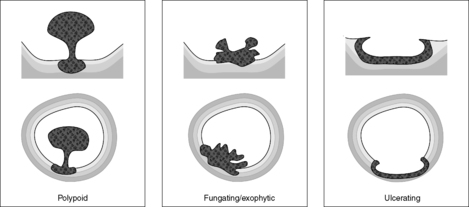classification, grading and staging
Tumours exhibit a wide variety of behaviour and have a myriad of possible effects. Pathological analysis of neoplasms aims to allow sensible correlation with aetiological factors, to help select the best treatment, and to predict the prognosis. This is done by:
• classifying neoplasms according to the type of normal tissue they resemble
• grading them according to how closely they resemble normal tissue
• staging them by how far they have spread through the body.
12.1. Pathological characteristics of neoplasms
Macroscopic (naked eye) examination gives a preliminary idea of the nature of the tumour, since the growth pattern depends on the site of origin, speed of growth and cellular characteristics. Polypoid neoplasms stand above the adjacent tissue surface; exophytic neoplasms also do so but in an irregular way; fungating neoplasms are large, exophytic tumours with necrosis and surface ulceration; while the term ulcerating is used for ulcerated neoplasms that grow into the underlying tissue without a large exophytic component (Figure 30).
 |
| Figure 30 |
Some clues as to whether the tumour is benign or malignant may be obtained by macroscopic examination. Infiltration of surrounding tissues implies malignancy, while a well-circumscribed tumour surrounded by a capsule of reactive fibrous tissue is more likely to be benign. Neoplasms with extensive necrosis or a fungating appearance are probably malignant.
The mainstay of routine pathological classification is still light microscopy using sections stained with haematoxylin and eosin (H&E). Sometimes, special stains, immunohistochemistry or molecular techniques (see Ch. 2) may be needed for accurate classification. In some tumours, characteristics such as hormone receptor expression may give additional information about how the tumour is likely to respond to treatment.
Tumour markers
Some tumours secrete substances which can be detected in the blood or urine (Table 17). They may be:
• substances normally produced by the tissue but in excessive amounts, e.g. PSA produced by prostatic carcinoma
• substances not normally produced by the tissue (ectopic production), e.g. adrenocorticotrophic hormone from a lung cancer
• substances usually only seen in primitive or fetal tissues, such as CEA and AFP.
| Marker | Tumour |
|---|---|
| Carcinoembryonic antigen (CEA) | Colorectal disease, benign and malignant |
| Human chorionic gonadotrophin (hCG) | Malignant teratoma |
| Alpha-fetoprotein (AFP) | Malignant teratoma, hepatocellular carcinoma |
| Prostatic specific antigen (PSA) | Prostate cancer |
| Vanillyl mandelic acid (VMA) | Neuroblastoma |
| 5-Hydroxy indole acetic acid (5HIAA) | Carcinoid tumour |
Tumour markers are used clinically in the initial diagnosis of a neoplasm and in monitoring its response to treatment. For example, detecting markedly raised PSA in the blood of a man with prostatic symptoms suggests prostatic carcinoma. After surgical resection of the cancer, the level of PSA should return to normal, but if it starts to rise again, it suggests recurrence of the cancer.
Prognostic factors in neoplasia
Many factors affect the prognosis of a patient with a neoplasm. It is useful conceptually to divide them into three groups:
• tumour-related factors
• host-related factors
• access to care.
Tumour-related factors
Host-related factors
These are characteristics of the patient. For example, other diseases, called co-morbidities in this context, may worsen the patient’s overall condition, or prevent optimum therapy (e.g. respiratory disease may prevent an anaesthetic for surgical resection). The very old and very young sometimes have a worse prognosis than the rest of the population.
Access to care
The available treatment may be important in prognosis, i.e. whether optimum care is available and whether the individual has access to that care. These are sometimes called ‘environment-related factors’.
12.2. Classification of neoplasms
Neoplasms are named according to whether they are benign or malignant (see Ch. 11) and by the type of tissue they resemble. In general, although there are important exceptions, benign neoplasms have the suffix -oma, malignant neoplasms arising from epithelial tissues are called carcinomas and malignant neoplasms arising from mesenchymal tissue are called sarcomas (Table 18
Buy Membership for Pathology Category to continue reading. Learn more here







